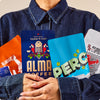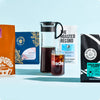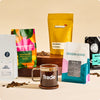Question: There are a few unmistakable signs of fall. Leaves turning colors. People trading in their shorts and bathing suits for flannel and scarves. As people switch from cold brews to hot coffees, there’s only one drink that’s so tied to the season it’s hard to imagine it being drunk any other time: the Pumpkin Spice Latte.
Pumpkin Spice Lattes show up on coffee shop menus around September and linger on until November. Most people are familiar with the Starbucks drink, which debuted in fall of 2003. But pumpkin spice has a storied history that reaches back centuries and is tied into the history of coffee long before it became the official drink of fall.
So where did the Pumpkin Spice Latte come from? We talked to Peter Guiliano, Chief Research Officer for the Specialty Coffee Association, to find out more.
Background information
Let’s start with a truth bomb: early versions of Pumpkin Spice Lattes did not have any actual pumpkin in them.
“I remember people sometimes being outraged by this,” Guliano says. “‘Did you know the pumpkin spice latte DOESN’T EVEN HAVE REAL PUMPKIN IN IT?!?!’ I remember high-end coffee shops making pumpkin puree so they could offer a ‘real’ pumpkin spice latte in opposition to the ‘fake’ Starbucks one. Starbucks responded to this — and probably consumer confusion — by obligingly adding pumpkin puree.”
Pumpkin spice originally referred to the spices traditionally paired with pumpkin: usually some combination of cinnamon, clove, nutmeg, ginger, and mace (some recipes use allspice instead of mace, but mace and nutmeg come from the same plant hence their association here). But these spices aren’t just grouped together because they’re great with pumpkin. Instead, their association with one another goes back to spice trading routes and that we might not even have coffee without this lucky combination of spices.
A little bit about pumpkin spice
In 2015, Guiliano wrote a blog post detailing the origins of the five pumpkin spices listed above. “All five ‘pumpkin’ spices have in their history a tiny clutch of islands in the Indonesian archipelago called the Moluccas (Muluku in Indonesian),” he writes. “In antiquity, these were known as the ‘Spice Islands’ because they were the source of spices.”
Spices were one of the first instances of trade across civilizations, and spice traders went through places like Yemen and the Port of Mokha, where coffee was first grown for commercial use as early as the 15th century. Guiliano notes that coffee was traded alongside pumpkin spices during this time. “Coffee was seen as a kind of spice until the 20th century; in fact the first trade magazine aimed at the coffee trade in the U.S. was called The Spice Mill since spice and coffee sellers were thought to be the same thing,” he says.
It was not uncommon for early coffee drinkers to mix their cups with pumpkin spices. Guliano references a passage from the book Travels in Arabia Deserta, written in 1888 by Charles Doughty:
*“The water bubbling in the small dellàl, he casts in his fine coffee powder, el-bunn, and withdraws the pot to simmer a moment. From a knot in his kerchief he takes then a head of cloves, a piece of cinnamon or other spice, bahar, and braying these he casts their dust in after.” *
Coffee has been made alongside our so-called pumpkin spices for centuries, long before pumpkin entered the picture. “Actually,” Guiliano says, “the weird thing is that we associate these spices with pumpkin instead of coffee!”
The long answer
Although pumpkin spices and coffee have enjoyed a long history together, this fact didn’t necessarily influence the modern-day PSL. “The combo of spice-islands spices and coffee wasn’t in the culture in the 80s and 90s,” he says. “What did happen is that coffeehouse culture embraced the idea of culinary creativity in drink design, seeking to move past the basics of the American and Italian coffee menus towards ‘signature’ drinks.”
Torani, a syrup company that began in 1925 by two Italian immigrants living in San Francisco, claims to have made the first syrup used for a flavored latte in 1982. Their vanilla syrup ended up in a latte, and from then on, they focused their energy on the specialty coffee industry. That didn’t stop others from concocting their own signature drinks. “I remember the company I worked for in 1993 having a contest called ‘Artista Barista,’” Guiliano says, “which encouraged baristas to design new, exciting drinks with interesting ingredients.” The search for the next flavored coffee drink was on.
Starbucks was also on the signature drink hunt during this time. The PSL is credited to Starbucks’ director of espresso, Peter Dukes, but it’s unclear if Starbucks actually was the first to develop the PSL as we know it today. Guiliano thinks it was likely invented by an anonymous barista, but the mega-chain is likely responsible for its mainstream popularity—and they had some interesting recipe development techniques. “In the course of developing the PSL,” writes Nina Friend for Food & Wine Magazine, “the Starbucks research and development team poured espresso shots on top of pumpkin pies, tasting different combinations to determine the best ratio of cinnamon and nutmeg to coffee and steamed milk.”
The PSL was tested at 100 Starbucks in Vancouver, British Columbia, and Washington, D.C., but the combination of spices wasn’t new to North America. Pumpkins are indigenous to the Americas, but traveled between Europe and America during the 16th and 17th centuries, with people using them for pie fillings soon thereafter. Amelia Simmons wrote the cookbook American Cookery in 1796, which the Smithsonian called ‘America’s First Cookbook,’ and in it she had two recipes for pumpkin pie, both containing some of the pumpkin spices.
Spice companies like Thompson & Taylor Spice Co and McCormick & Company began selling blends that combined common “pumpkin spices” in one container in the 1930s, so their association with one another was likely solidified in American culture at this time, even though their shared origins and history means they’ve been hanging out together for quite some time. In a way, all these different trajectories and histories came together in 2015, when Starbucks retooled the PSL to include actual pumpkin. Finally, pumpkin, coffee, and pumpkin spices were all together in one cohesive drink.
The short answer
You could almost write the history of the Pumpkin Spice Latte without pumpkins. The combination of cinnamon, clove, ginger, nutmeg, and mace with coffee predates pumpkins and pumpkin pie by centuries.
Pumpkin pie became a popular food item by the 18th century and combined some of the spices we now know as pumpkin spice. Spice companies began grouping them together and selling them as a package deal in the 1930s. The Pumpkin Spice Latte as we know it came through a push in the ‘80s and ‘90s for more signature espresso drinks, and while Starbucks likely didn’t invent the PSL, they’re likely the reason the drink is as popular as it is today. Since 2003, they’ve sold more than 424 million PSLs globally and it is their single-most popular seasonal drink.
Try making your own pumpkin spice syrup at home! There are hundreds of recipes online, including this one from 2007 World Barista Champion James Hoffmann.






